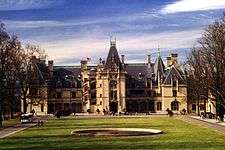Richard Morris Hunt
| Richard Morris Hunt | |
|---|---|
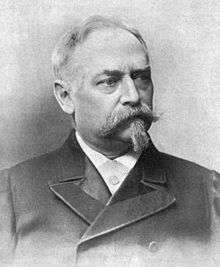 | |
| Born |
October 31, 1827 Brattleboro, Vermont |
| Died |
July 31, 1895 (aged 67) Newport, Rhode Island |
| Nationality | American |
| Alma mater | École des Beaux-Arts |
| Occupation | Architect |
| Spouse(s) | Catherine Clinton Howland |
| Buildings |
New York Tribune Building William K. Vanderbilt House Marble House |
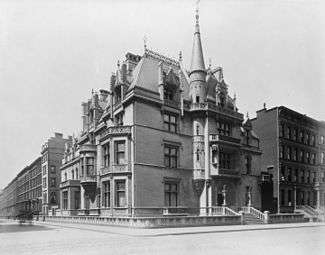
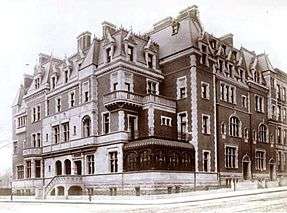
Richard Morris Hunt (October 31, 1827 – July 31, 1895) was an American architect of the nineteenth century and a preeminent figure in the history of American architecture. Hunt was, according to design critic Paul Goldberger writing in The New York Times, "American architecture's first, and in many ways its greatest, statesman."[1] Aside from Hunt's sculpting of the face of New York City, including designs for the facade and Great Hall of the Metropolitan Museum of Art, the pedestal of the Statue of Liberty and many Fifth Avenue mansions lost to the wrecking ball,[2] Hunt founded both the American Institute of Architects and the Municipal Art Society.
Life and career
Born at Brattleboro, Vermont, Hunt was a son of Jane Maria Leavitt, born to an influential family of Suffield, Connecticut, and Hon. Jonathan Hunt, a U.S. congressman whose own father was the lieutenant governor of Vermont, and scion of the wealthy and prominent Hunt family of Vermont.[3] Richard Morris Hunt was the brother of the Boston painter William Morris Hunt, and the photographer and lawyer Leavitt Hunt. (Hunt was named for Lewis Richard Morris, a family relation,[4] who was a U.S. Congressman from Vermont and the nephew of Gouverneur Morris, an author of large parts of the U.S. Constitution.)[5]
Following the early death of his father, Hunt's mother took the family to Europe, where they remained for more than a decade, first in Switzerland and later in Paris. Hunt began his education at the Boston Latin School. Following Hunt's 1843 graduation from Boston Latin,[6] young Hunt left with his family for Europe, where he studied art, and where he was encouraged to pursue architecture by his older brother William, a painter, and by his mother, who had been denied the chance to paint herself.[7]
Hunt later entered the Paris atelier of Hector Lefuel in 1846. The aspiring architect Hunt became the first American to attend the École des Beaux-Arts in Paris. "Hunt was the first American to be admitted to the school of architecture at the École des Beaux-Arts – the finest school of architecture in the world – and the subsequent importance of his influence on the architecture of his own country can hardly be overstated," writes historian David McCullough.[8]
Hunt's mentor Lefuel later permitted him to supervise work on the Louvre museum, which Lefuel and Louis Visconti were renovating for Napoleon III, as well as to design the Pavillon de la Bibliothèque (“Library Pavilion”), prominently situated opposite the Palais-Royal.[9] Hunt would later regale aspiring young architect Louis Sullivan with stories of his work on the New Louvre in Lefuel's atelier libre.[10]
After his return in 1855, Hunt founded the first American architectural school at his Tenth Street Studio Building (beginning with only four students), co-founded the American Institute of Architects and from 1888 to 1891 served as the Institute's third president, brought the first apartment building to Manhattan in a burst of scandal, and set a new ostentatious style of grand houses for the social elite and the eccentric, competitive new millionaires of the Gilded Age. His philosophy of architectural work may be summed up in his quote "The first thing you've got to remember is that it's your client's money you're spending. Your goal is to achieve the best results by following their wishes. If they want you to build a house upside down standing on its chimney, it's up to you to do it."[11]
Hunt's greatest influence was his insistence that architects be treated, and paid, as legitimate and respected professionals equivalent to doctors and lawyers.[12] He sued one of his early clients for non-payment of his five percent fee, which established an important legal precedent.[13] One of his 1859 students at the Tenth Street Studio, William Robert Ware, was deeply influenced by Hunt and went on to found the first two university programs in architecture: MIT in 1866, and Columbia in 1881.
Hunt married Catherine Clinton Howland on April 2, 1861. She was the daughter of Samuel S. Howland.[14]
His extensive social connections in Newport[15] among the richest Americans of his generation, were informed by his energy and good humor. Legend has it that while on a final walk-through of one of his Vanderbilt mansions, Hunt discovered a mysterious tent-like object in one of the ballrooms. Investigating, he found it was canvas covering a life-sized statue of himself, dressed in stonecutters' clothes, all carved in secret as a tribute by the gang of stonecutters working on the house. Vanderbilt permitted the statue to be placed on the roof of the mansion.
Most who came into contact with Hunt came away struck by the man. On their first meeting in 1869 Ralph Waldo Emerson spoke of "one remarkable person new to me, Richard Hunt the architect. His conversation was spirited beyond any I remember, loaded with matter, and expressed with the vigour and fury of a member of the Harvard boat or ball club relating to the adventures of one of their matches; inspired, meantime, throughout, with fine theories of the possibilities of art."[16]
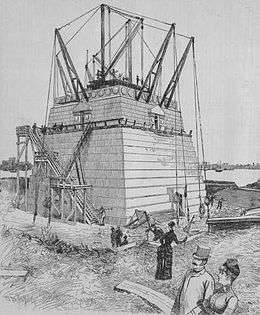
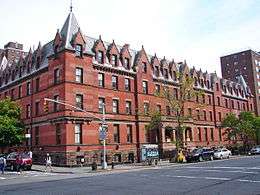
Hunt's folksy manner, lack of pretense and unbridled enthusiasm led Emerson to gush, "I could only think of the immense advantage which a thinking soul possesses when horsed on a robust and vivacious temperament. The combination is so rare of an Irish labourer's nerve and elasticity with Winckelmann's experience and cultivation as to fill one with immense hope of great results when he meets it in the New York of to-day."
Hunt designed New York's Tribune Building, one of the earliest with an elevator, in 1873. Other buildings of note that Hunt designed include the Theological Library and Marquand Chapel in Princeton, the Scroll and Key building at Yale, and the Fogg Museum of Art at Harvard. Until the Lenox Library, none of Hunt's American works were in the Beaux-Arts style with which he is associated. Late in his life he became involved in the Chicago's World's Columbian Exposition in 1893, at which his Administration Building received the gold medal from the Royal Institute of British Architects.
In New York City, Hunt's handiwork can be seen on the austere pedestal of the Statue of Liberty and on the elegant 5th Avenue facade of the Metropolitan Museum of Art. The last surviving New York City building entirely by Hunt is the charity hospital he designed for the Association for the Relief of Respectable Aged Indigent Females (1883) on the east blockfront of Amsterdam Avenue between 103rd and 104th Streets in Manhattan. The red-brick building, which features dormer windows and a mansard roof similar to those Hunt used on his Biltmore Estate in Asheville, North Carolina, was renovated in the late 20th century and is now a youth hostel.
Among the employees who worked in Hunt's firm was Franco-American architect and fellow Ecole des Beaux Arts graduate Emmanuel Louis Masqueray who went on to be Chief of Design at the Louisiana Purchase Exposition in St. Louis. Hunt often employed sculptor Karl Bitter to enrich his designs. Both Hunt and his frequent collaborator, landscape architect Frederick Law Olmsted, were associated with the City Beautiful Movement, and Hunt was the first president of the Municipal Art Society that grew out of the movement. Nevertheless, Olmsted, an advocate of "naturalistic" architecture and landscape design famously clashed with Hunt in 1863 over Hunt's proposal for "Scholars' Gate", a formal entrance to Central Park at 60th Street and Fifth Avenue. According to Central Park historian Sarah Cedar Miller, Central Park Commissioner and influential New Yorker Andrew Haswell Green, was a major supporter of Hunt. When the park commissioners adopted Hunt's design, Olmsted and his partner Calvert Vaux protested and resigned their positions with the Central Park project. Hunt's plan for Scholars' Gate was never built and Olmsted and Vaux subsequently rejoined the project.[17] Nevertheless, there were to be other reminders of Hunt in Central Park.
Hunt died in 1895 and was buried at the Common Burying Ground and Island Cemetery in Newport, Rhode Island. In 1898, 3 years after Hunt's death in Newport, the Municipal Art Society commissioned the Richard Morris Hunt Memorial, designed by sculptor Daniel Chester French and architect Bruce Price.[18] The memorial is installed in the wall of Central Park across Fifth Avenue from today’s Frick Museum at 70th Street. Following Hunt's death, his son Richard Howland Hunt took over the practice his father had established.[19]

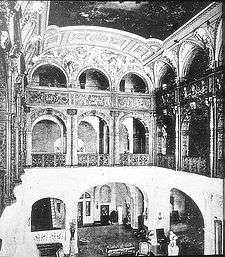

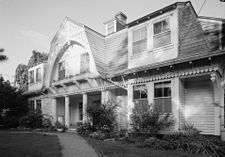

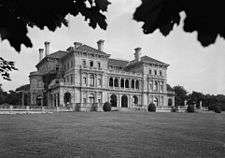
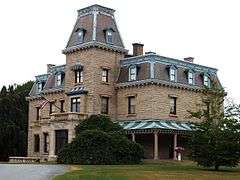
Among the many projects Richard Howland Hunt finished was the great entrance hall of the Metropolitan Museum of Art, for which his father, a Metropolitan trustee, had made the initial sketches in 1894, having earlier designed the Museum's Fifth Avenue facade.[20][21]
Works
Residences
- Everett-Dunn House, Tenafly, NJ, 1867[22]
- H. B. Hollins' Country Estate, "Meadow Farm", East Islip, NY
- J.N.A. Griswold House, Newport, RI 1863–64
- Jacob Haskell House, Orient Street, Swampscott, MA, 1871-73[23]
- Stuyvesant Apartments, 1869
- Marshall Field House, Prairie Avenue, Chicago, 1873
- Chateau-sur-Mer, 1870-1873, and 1876-1880[24]
- William K. Vanderbilt House, "Petit Chateau", New York City, 1878–82.[25]
- Henry Marquand House, NYC, 1881–84[26]
- James Pinchot House, Grey Towers, Milford, Pennsylvania 1884–86
- William Borden House, Chicago, Illinois, 1884–89
- Ogden Mills House, Fifth Avenue, NYC, 1885–87
- Château de Montméry (Theodore Haviland), Ambazac, Haute Vienne (87), France, 1885
- Archibald Rogers Estate, Hyde Park New York, 1886–89
- William Kissam Vanderbilt House, "Marble House", Newport, Rhode Island, 1888–92
- J.R. Busk House, "Indian Springs", presently known as Wrentham House, Newport, Rhode Island, 1889–92
- Ogden Goelet House, "Ochre Court", Newport, Rhode Island, 1888–93
- Oliver Belmont House, "Belcourt Castle", Newport, Rhode Island, 1891
- Elbridge Gerry House, NYC, 1891–94 Newport, Rhode Island,
- John Jacob Astor IV House, Fifth Avenue, NYC, 1891–95
- Dorsheimer-Busk House, Newport, Rhode Island, 1890–93
- George Washington Vanderbilt House, "Biltmore Estate", the largest private mansion in America Asheville, North Carolina, 1890–
- Cornelius Vanderbilt II house, "The Breakers", Newport, Rhode Island, 1892–95
Churches
- St. Mark's Episcopal Church, Islip, Long Island, New York
- Cathedral of All Souls, Biltmore Village, Asheville, North Carolina
Commercial buildings
- New York Tribune Building, New York, 1875.
- Southern Railway Biltmore Station, One Biltmore Plaza, Asheville, North Carolina, 1896.[27]
Public buildings
- Howland Cultural Center (Howland Library), Beacon, NY, designed for Hunt's brother-in-law Joseph Howland, Howland Cultural Center
- Fogg Art Museum, Cambridge, Massachusetts, 1892–95 (demolished and replaced).
- Administration Building, World's Columbian Exposition, Chicago, 1893[28]
- Clark Hall, Case Western Reserve University, Cleveland, OH
- Virginia Hall (and other buildings) Hampton Institute (now Hampton University), Hampton, VA
- Lenox Library, New York, NY
- Metropolitan Museum of Art façade and Grand Stairway, New York, NY
Urban design
- Master plan for Columbia University Morningside Heights campus, New York, NY
Awards and honors
- Honorary Doctorate, Harvard University, Cambridge, Massachusetts (first architect to receive the honor)[29]
- Royal Gold Medal, Royal Institute of British Architects, 1893 (first American architect to be so honored)
- Honorary member, Académie française
- Chevalier of the Legion of Honor, France[30]
See also
- Thaddeus Leavitt
- Jarvis Hunt
- Jonathan Hunt (Vermont Representative)
- Jonathan Hunt (Vermont Lieutenant Governor)
- Leavitt Hunt
- William Morris Hunt
References
Notes
- ↑ Architecture: Two Richard Morris Hunt Shows, Paul Goldberger, The New York Times, May 22, 1986
- ↑ The Harvard Graduates' Magazine, Vol. I, Published by the Harvard Graduates' Magazine Association, Boston, 1893
- ↑ The History of the Descendants of John Dwight, of Dedham, Mass., Benjamin Woodbridge Dwight, New York, 1874
- ↑ Lewis Richard Morris was married to Ellen Hunt, sister of Richard Morris Hunt's father.General Lewis R. Morris House, Springfield, Vt., National Register, Connecticut River Joint Commissions, crjc.org
- ↑ Obituary of Richard Morris Hunt, The New York Times, August 1, 1895
- ↑ Built in Boston: City and Suburb, 1800–2000, Douglass Shand-Tucci, University of Massachusetts Press, 1999, ISBN 1-55849-201-1, ISBN 978-1-55849-201-1
- ↑ Puritan Boston & Quaker Philadelphia, Edward Digby Baltzell, Published by Transaction Publishers, 1996 ISBN 1-56000-830-X
- ↑ McCullough, David (2011). The Greater Journey: Americans in Paris. New York: Simon & Schuster.
- ↑ The History of the Descendants of John Dwight, of Dedham, Mass., Vol. I, Benjamin W. Dwight, Published by John F. Trow & Son, New York, 1874
- ↑ Louis Sullivan, Prophet of Modern Architecture, Hugh Morrison, W. W. Norton & Co., New York, 1998
- ↑ van Pelt, A Monograph of the William K. Vanderbilt House, 10, cited in Vanderbilt, Arthur T. Fortune's Children. William Morrow and Co., 1989, 89.
- ↑ Hunt was aided in his insistence on the place of architects in the social hierarchy by his own independent wealth and social connections.
- ↑ Engineering Magazine, Vol. 10, The Engineering Magazine Co., New York, 1896
- ↑ "Richard Morris Hunt". Back Bay Houses. Retrieved 21 April 2015.
On April 2, 1861, he married Catherine Clinton Howland, daughter of Samuel S. Howland.
- ↑ Hunt himself lived during the season in Newport, where his wife, the New York City heiress Catherine Clinton Howland, had extensive family connections.
- ↑ Ralph Waldo Emerson (1914). Edward Waldo Emerson and Waldo Emerson Forbes, ed. Journals of Ralph Waldo Emerson, 1864–1876. Boston: Houghton Mifflin Company. p. 280.
- ↑ Miller, Sara Cedar: Central Park, An American Masterpiece p. 57. Harry N. Abrams, Inc, 2003 ISBN 0-8109-3946-0.
- ↑ History of the Municipal Art Society (official site)
- ↑ Prominent Families of New York, The Historical Company, New York, 1897
- ↑ Long Island Country Houses and Their Architects, 1860–1940, Robert B. MacKay, Anthony K. Baker, Carol A. Traynor, W. W. Norton & Co., New York, 1997
- ↑ Finding aid for the Henry Gurdon Marquand Papers, 1852-1903
- ↑
- ↑ Thompson, Waldo (1885). Swampscott: Historical Sketches of the Town. p. 205.
- ↑ http://www.newportmansions.org/learn/architecture/aspects-of-architecture-design/chateau-sur-mer
- ↑ Craven, Wayne (2009). Gilded Mansions: Grand Architecture and High Society. New York: W. W. Norton & Company. pp. 111–126. ISBN 978-0-393067-54-5.
- ↑ Henry Gurdon Marquand joined Charles McKim as a pallbearer at Hunt's funeral.
- ↑ Potter, Janet Greenstein (1996). Great American Railroad Stations. New York: John Wiley & Sons, Inc. p. 266. ISBN 978-0471143895.
- ↑ Gold medal from the Royal Institute of British Architects.
- ↑ The Harvard Graduates' Magazine, Vol. I, William Roscoe Thayer, The Harvard Graduates' Magazine Association, The Riverside Press, Cambridge, Mass., 1893
- ↑ The Look of Architecture, Witold Rybczynski, Oxford University Press, 2003
Bibliography
- Baker, Paul, Richard Morris Hunt, MIT Press, 1980
- Durante, Dianne, Outdoor Monuments of Manhattan: A Historical Guide (New York University Press, 2007): brief summary of Hunt's career and description of Daniel Chester French's Hunt memorial in Central Park, New York.
- Great Buildings Online
- Kvaran. Einar Einarsson, Architectural Sculpture of America
- Stein, Susan Editor, The Architecture of Richard Morris Hunt, University of Chicago Press, 1986
Further reading
- Exploration, Vision & Influence: The Art World of Brattleboro's Hunt Family, Catalogue, Museum Exhibition, The Bennington Museum, Bennington, Vermont, June 23 – December 31, 2005, Paul R. Baker, Sally Webster, David Hanlon, and Stephen Perkins
External links
![]() Media related to Richard Morris Hunt at Wikimedia Commons
Media related to Richard Morris Hunt at Wikimedia Commons
- Richard Morris Hunt at Find a Grave
- Death of Richard Morris Hunt, One of the Foremost Architects of the United States, The New York Times, August 1, 1895
- Additional obituary, Richard Morris Hunt, The New York Times, August 1, 1895
- nyc-architecture.com
- Richard Morris Hunt collection, The Octagon Museum, The Museum of The American Architectural Foundation, Washington, D.C.
